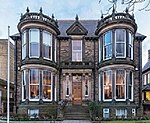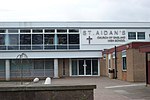Vale of York Hoard
10th century in England2007 archaeological discoveries2007 in England2007 in scienceArchaeological sites in North Yorkshire ... and 9 more
Collections of the Yorkshire MuseumHarrogateHistory of North YorkshireHoards of jewelleryMedieval European objects in the British MuseumMetal detecting finds in EnglandTreasure troves in EnglandUse British English from October 2021Viking treasure troves

The Vale of York Hoard, also known as the Harrogate Hoard and the Vale of York Viking Hoard, is a 10th-century Viking hoard of 617 silver coins and 65 other items. It was found undisturbed in 2007 near the town of Harrogate in North Yorkshire, England. The hoard was the largest Viking one discovered in Britain since 1840, when the Cuerdale hoard was found in Lancashire, though the Anglo-Saxon Staffordshire Hoard, found in 2009, is larger.
Excerpt from the Wikipedia article Vale of York Hoard (License: CC BY-SA 3.0, Authors, Images).Vale of York Hoard
Knaresborough Road,
Geographical coordinates (GPS) Address Nearby Places Show on map
Geographical coordinates (GPS)
| Latitude | Longitude |
|---|---|
| N 53.992 ° | E -1.527 ° |
Address
Knaresborough Road
Knaresborough Road
HG1 5QR , High Harrogate
England, United Kingdom
Open on Google Maps










